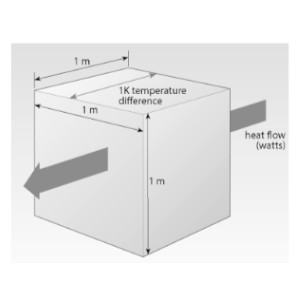WHAT IS THERMAL CONDUCTIVITY ? | FORMULA
 Thermal conductivity, also known as the Lambda (λ) value, comes from from the Greek numeral system and has a value up to 30. It is measured in Watts per Meter Kelvin (W/mK).
Thermal conductivity, also known as the Lambda (λ) value, comes from from the Greek numeral system and has a value up to 30. It is measured in Watts per Meter Kelvin (W/mK).  The lambda value is a characteristic of a material that indicates how efficiently it conducts heat, whether it is thermal insulation or glass. In other words, it represents the material's ability to transfer energy through conduction. The λ-value is crucial for calculating the R-value and U-value.
The lambda value is a characteristic of a material that indicates how efficiently it conducts heat, whether it is thermal insulation or glass. In other words, it represents the material's ability to transfer energy through conduction. The λ-value is crucial for calculating the R-value and U-value.
From a mathematical perspective, the lambda value signifies the rate of energy transmission through 1m² of material, 1m thick, with a temperature difference of 10°C on both sides.
Lambda values are typically used to compare different material properties, making this property essential in designing high-performance buildings and passive houses. In Europe, the lambda value [λ] of a material is required. In other words this is the information that manufacturers must include in the product's pdf data sheet.
Pic. Heat flow and thermal conductivity
Pic.credit:open.edu
WHAT IS A GOOD THERMAL CONDUCTIVITY VALUE FOR INSULATION?
In general, the lower the conductivity the better the level of insulation. To determine whether we are dealing with material that has good thermal conductivity, it is good to know its lambda value then compare it to other materials on the scale.
An effective insulation material aims for the lowest possible lambda value to minimise heat loss. To illustrate, glass fibre insulation boasts a thermal conductivity of 0.044 W/mK, whereas dense concrete has a thermal conductivity of around 1.5 W/mK. To emphasise further, copper has a considerably higher lambda value of 401 W/mK, explaining its common usage in applications such as plumbing and electrical systems.
Generalising, an insulation material with good thermal conductivity is one with a value no higher than 0.030W/mK.
Values of thermal conductivity above 0.030W/mK would require using a thicker insulation layer, which may not always be possible.
THERMAL CONDUCTIVITY OF INSULATION MATERIALS | COMPARISON
Insulation material thermal conductivity is usually printed on the packaging, listed on the manufacturers website, alternatively on the product pdf datasheet.
Below, we present sample thermal conductivity values for conventional insulation materials from the highest (worse) to the lowest (better).
- Straw - 0.08W/mK
- Expanded polystyrene - 0.030-0.045W/mK
- Mineral or glass wool - 0.032-0.044W/mK
- Wood fibre - 0.038W/mK
- Hemp - 0.038W/mK
- Cellulose fibre - 0.04W/mK
- Cork - 0.04W/mK
- Sheep wool - 0.036W/mK
- PIR (polyisocyanurate foam) - 0.022W/mK
- Phenolic foam - 0.018W/mK
- Aerogel - 0.012-0.016W/mK
THERMAL CONDUCTIVITY OF BUILDING MATERIALS
Various materials, including insulation types and others, possess distinct thermal conductivity values that serve as indicators of their insulating capabilities. For instance, metals exhibit high thermal conductivities, allowing significant heat transmission even for minor temperature differentials. Elements like metal window frames, lintels, and insulation fixings may act as "thermal bridges" or "cold bridges," transmitting substantial heat despite their limited total area. In contrast, window glass, characterised by high conductivity, sees minimal impact on its overall U-value when using thicker glass. While structural building materials like brick and concrete have lower conductivities, the expansive surface areas of walls and roofs still pose the potential for considerable heat losses.
Below, we present the thermal conductivity values of common building materials:
- Insulation PIR board – 0.022W/mK
- Insulation mineral wool batt - 0.040W/mK
- Brick work - 0.77W/mK
- Concrete block - 1.93W/mK
- Aluminium - 220W/mK
- Glass - 0.57W/mK
- Plaster – 0.18W/mK
- Steel - 60W/mK
- Timber – 0.13W/mK
- Aerated concrete - 0.11W/mK
INSULATION LAMBDA CALCULATION
The thermal conductivity coefficient, lambda (λ), is measured by taking samples of a particular material under laboratory conditions - typically at a temperature of 10 degrees Celsius. The results obtained from these samples are then summed up and divided by their quantity. This process allows for the calculation of the average lambda coefficient. Often, achievable heat transfer coefficient values are also provided, representing the best result among the collected sample outcomes.
Related Searches:
THE TOP LOW-COST INSULATION CHOICES FOR YOUR HOME
R-VALUES THE BRITISH WAY: YOUR PROJECT'S THERMAL JOURNEY WITH A DOSE OF UK HUMOR!
WHAT TO CONSIDER WHEN CHOOSING INSULATION MATERIALS
DOUBLE INSULATION LAYERS: INSTALLATION TIPS
THE PRICE OF COMFORT: UNRAVELLING WHY INSULATION IS SO EXPENSIVE
MASTERING THE ART OF CUTTING CELOTEX AND KINGSPAN INSULATION BOARDS: TECHNIQUES, TOOLS, AND SAFETY
*Insulationgo LTD strives to keep the content accurate and up-to-date, but we cannot be held responsible for any mistakes or exclusions.
The information in this article isn't expert advice and shouldn't replace talking to the right specialists. Before buying or deciding anything based on this info, it's best to contact the product manufacturer directly to double-check if it's right for what you need.
Descriptions, drawings, photographs, data, proportions, weights, and measured values provided here may change without prior notice and do not establish the guaranteed contractual quality of the products. The recipient of these products holds the responsibility to comply with proprietary rights, existing laws, and legislation.
Using this articles implies acknowledgment and agreement that Insulationgo LTD cannot be held accountable for any damages, losses, or inconveniences resulting from the use or reliance upon the information provided. This limitation of liability extends to all users of the article, including visitors, readers, and subscribers.










































































































